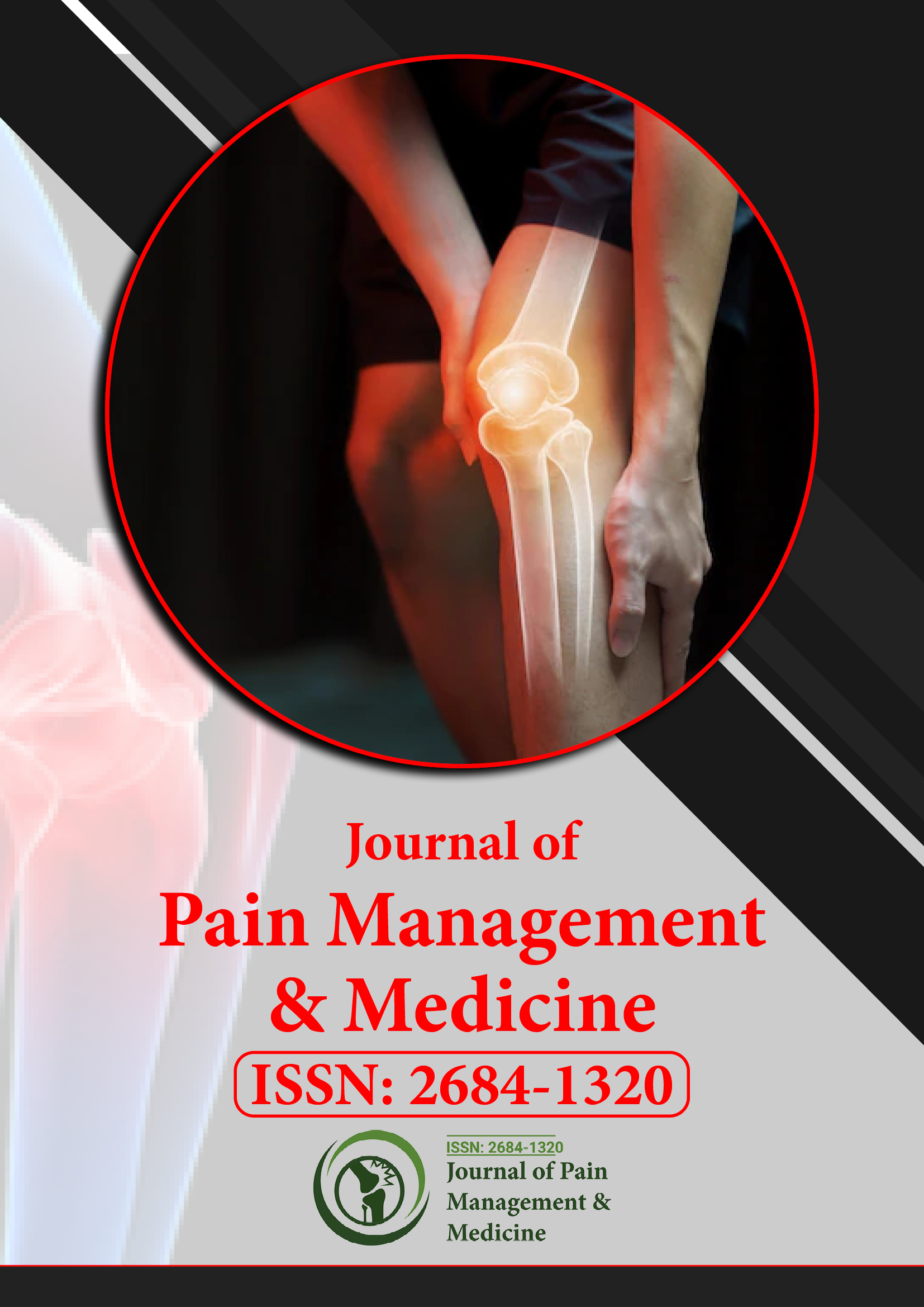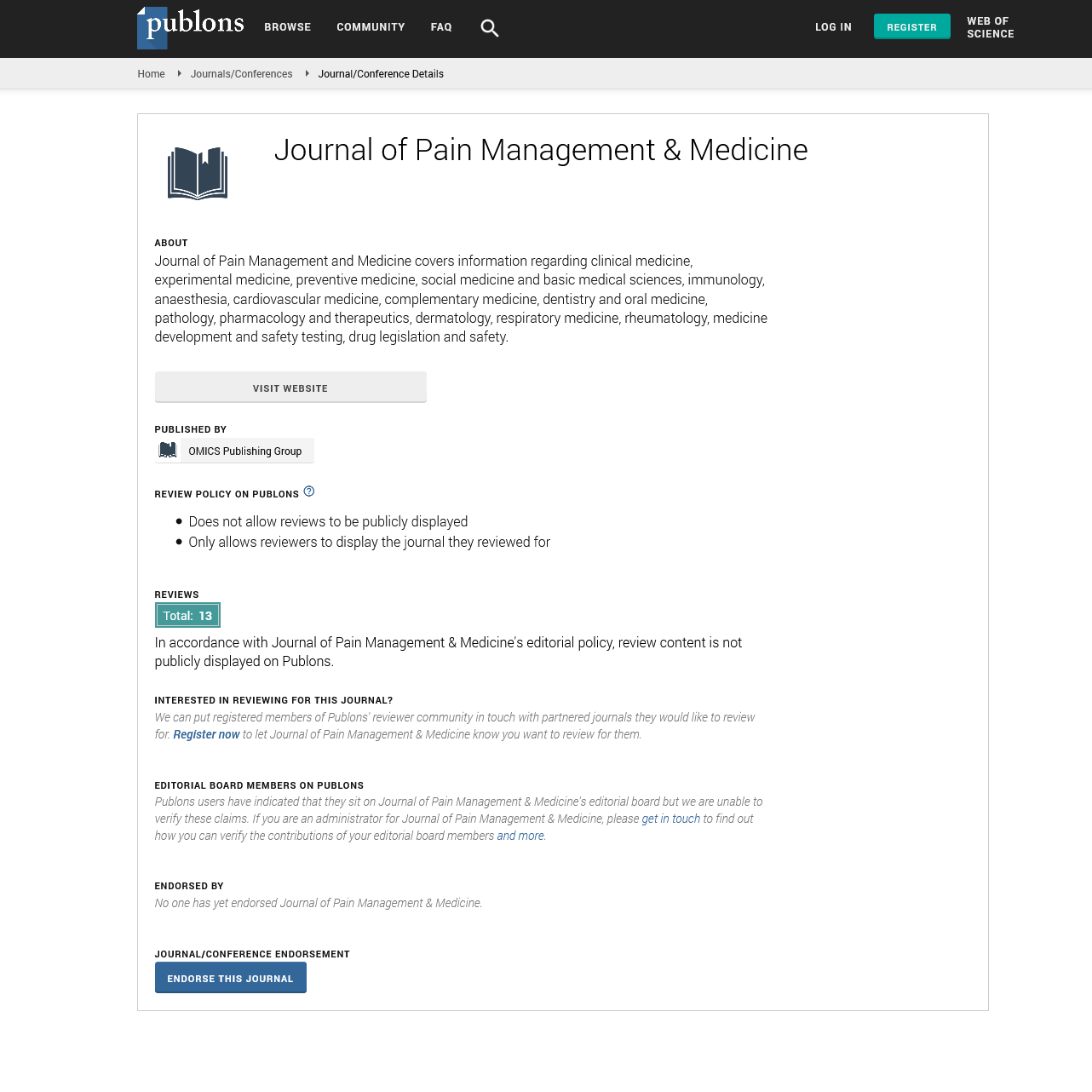Indexed In
- RefSeek
- Hamdard University
- EBSCO A-Z
- Publons
- Euro Pub
- Google Scholar
- Quality Open Access Market
Useful Links
Share This Page
Journal Flyer

Open Access Journals
- Agri and Aquaculture
- Biochemistry
- Bioinformatics & Systems Biology
- Business & Management
- Chemistry
- Clinical Sciences
- Engineering
- Food & Nutrition
- General Science
- Genetics & Molecular Biology
- Immunology & Microbiology
- Medical Sciences
- Neuroscience & Psychology
- Nursing & Health Care
- Pharmaceutical Sciences
Short Communication - (2021) Volume 7, Issue 2
Pain Relief: A New Hope
Michael Parker*Received: 09-Mar-2021 Published: 30-Mar-2021, DOI: 10.35248/2684-1320.21.7.150
Description
Today, opioids restricting to the mu- opioids receptor (mu) stay the essential analgesics used to treat torment conditions, driving an always expanding pace of - opioids remedies throughout the most recent twenty years. Shockingly, long haul remedial regimens are confounded by results going from the milder clogging, heaving, and queasiness, to more serious symptoms of respiratory sorrow, resilience, actual reliance, and at last maltreatment risk and deadly excess .These confusions essentially sway the personal satisfaction of patients and, as per a few ongoing reports, are viewed as a main thrust of the flow-opioids plague. Unmistakably, the improvement of imaginative treatments that different opioids absense of pain from these negative results is basic in diminishing this emergency. Justifiably, ongoing logical endeavors are endeavoring to outfit the intense pain relieving impacts of muagonism with new methodologies to limit muagonist-related results.
A large portion of these endeavors have zeroed in on the idea of ''one-sided'' opioids ligands, which can act through either G-protein or Arrest in intervened pathways. Be that as it may, while conceivably encouraging by their own doing, a portion of these'' one-sided ligand'' approaches at a solitary receptor have been uncovered to have expected limits. As an outcome of a portion of these impediments, specialists have additionally tried to reconsider non-particular opioids agonists and grow new bi practical agonists as arising fundamental science research has exhibited the estimation of all the while focusing on various opioids receptors inside fringe and focal torment and award frameworks. At last, these essential experiences into the complex useful collaborations of torment tweaking frameworks could likewise give a way to contriving new systems in drug improvement. As of late, considerable advancement has been made in the advancement of mu and Nociception Opioids Peptide (NOP) receptor bi utilitarian agonists. Mu and NOP share normal flagging pathways to Gi-interceded inhibitory organizations, and they are likewise both practically communicated in torment and award pathways. Now and again, NOP agonists have been appeared to have more extensive potential for the treatment of neuropathic torment than traditional opioids Specifically, NOP has been demonstrated to be an empowering objective for the treatment of agony in non-human primates. Early examinations have likewise shown the capability of blended mu/NOP agonists to mitigate results of average mu agonists, including the advancement of resilience and reliance. Strangely, this impact could be because of the ongoing desensitization of NOP motioning in remuneration and resistance circuits. Also, perceptions from clinically endorsed opioids mixtures like buprenorphine have driven another reasoning for the improvement of bivalent mu/NOP agonists as possible therapeutics in torment the board With their new distribution in Science Translational Medicine, Ding and associates looked to test this reasoning with the advancement of a bi practical mu/NOP agonist, AT-121, and afterward to completely analyze its potential as a non-addictive, pain relieving elective. The creators started by creating bifunctional NOP/mu agonists through structure-guided medication plan and advancement beginning from a NOP-specific substance framework[1-5].
Following the compound lead from their NOP ligand library, the creators utilized objective design movement relationship (SAR) advancement with Com-pound 1, the dynamic state NOP structure they had recently evolved, to incorporate 5 extra analogs with improved NOP restricting proclivity. The creators at that point utilized in vitropharmacological restricting and practical tests to every one of the opioids receptor subtypes to set up a thorough pharmacological profile of each bifunctional agonist. From the information gathered with these tests, Analog 5 showed high intensity and fractional agonist adequacy at both NOP and mu receptors. In contrast with any remaining analogs, the creators decided AT-121 as the best model ligand to investigate their theory that a harmony among NOP and mu agonist efficacies could be a valuable way to deal with grow new analgesics with diminished results. At last, the creators tended to another significant confusion of rehashed treatment with standard opioids analgesics, that of actual reliance, - opioids initiated hyperalgesia, and resistance. Past work has shown that primates and people rapidly create actual reliance following rehashed openness tomu agonists. In such conditions, rival organization causes withdrawal manifestations that adversely sway respiratory and cardiovascular action in primates. To look at whenever rehashed AT-121 organization encourages actual reliance, the creators over and over regulated AT-121or morphine for 3 days followed by opponent organization on day 4.
True to form, naltrexone encouraged withdrawal signs, while a mix of naltrexone and J-113397 didn't deliver any progressions in AT-121-treated creatures. In any case, ongoing AT-121 treatment didn't drive any resilience to antinociceptive impacts of AT-121. These outcomes evil spirit strate that, in spite of ordinary muagonists, rehashed organization of AT-121 doesn't cause opioids incited hyperalgesia and may moderate the advancement of pain relieving resilience contrasted with morphine.
The examination by Ding et al. unmistakably exhibits AT-121's guarantee as a torment helpful, yet there are admonitions in completely understanding the results of constant NOP/mu receptor organization. Numerous examinations have assessed NOP agonists' momentary impacts in regulating torment related reacting andreward looking for conduct, yet the outcomes of persistent NOP/mu receptor incitement during ongoing agony states or non-torment states has not been completely clarified. In truth, the creators inspected a moderately short ''persistent'' organization and found no consequences for resilience or hyperalgesia. Nonetheless, executing longer organization regimens just as assessing their belongings in remuneration looking for ideal models portrayed here would extraordinarily reinforce future examinations. Moreover, a basic evaluation of how ongoing AT-121 organization, and comparative mixtures, may impact general emotional states is justified as current examinations are investigating the part of the NOP framework in adjusting negative full of feeling states like uneasiness and discouragement. Despite these restrictions, AT-121 is a generous expansion to the thorough advancement of novel, elective pharmacotherapies required for fruitful agony the board and opioids maltreatment treatment. The creators gave a significant commitment in explaining the potential job bifunctional opioids agonists have in encouraging relief from discomfort while preparing for advancement of novel opioids analgesics with improved pharmacological profile.
REFERENCES
- Zamarripa AC, Edwards SR, Qureshi HN, Yi JN, Blough BE, Freeman KB. The G-protein biased mu-opioidagonist, TRV130, produces reinforcing and anti-nociceptive effects that are comparable to oxy-codone in rats. Drug Alcohol Depend. 2018;192:158–162.
- Ding H, Kiguchi N, Yasuda D, Daga PR, Polgar WE, Lu JJ, et al. A bifunctional nociceptin and mu opioid receptor agonist isanalgesic without opioid side effects in nonhuman primates. Sci Transl Med. 2018;10(456):eaar3483
- Ko MCH, Divin MF, Lee H, Woods JH, Traynor JR. Differential in vivo potenciesof naltrexone and 6b-naltrexol in the monkey. J Pharmacol Exp Ther. 2006;316(2):772–779.
- Ko MC, Woods JH, Fantegrossi WE, Galuska CM, Wichmann J, Prinssen EP. Behavioral effects of a synthetic agonistselective for nociceptin/orphanin FQ peptide re-ceptors in monkeys. Neuropsychopharmacology. 2009;34:2088–2096.
- Lutfy K, Hossain SM, Khaliq I, Maidment NT. Orphanin FQ/nociceptin attenuates the development of morphine tolerance in rats. Br J Pharmacol. 2009;134:529–534
Citation: Parker M (2021) Pain Relief: A New Hope. J Pain Manage Med. 7:150
Copyright: © 2021 Parker M. This is an open access article distributed under the terms of the Creative Commons Attribution License, which permits unrestricted use, distribution and reproduction in any medium, provided the original work is properly cited.

